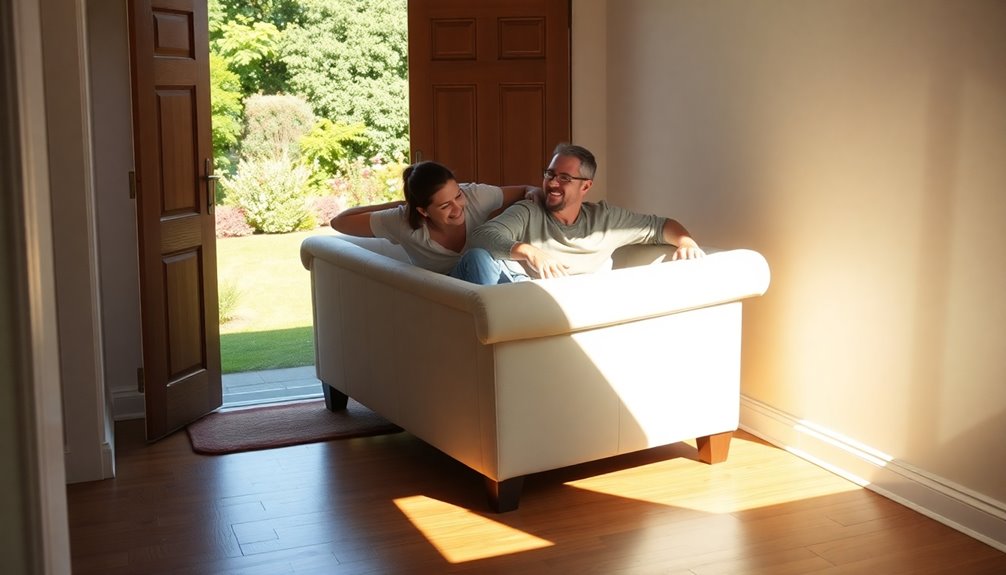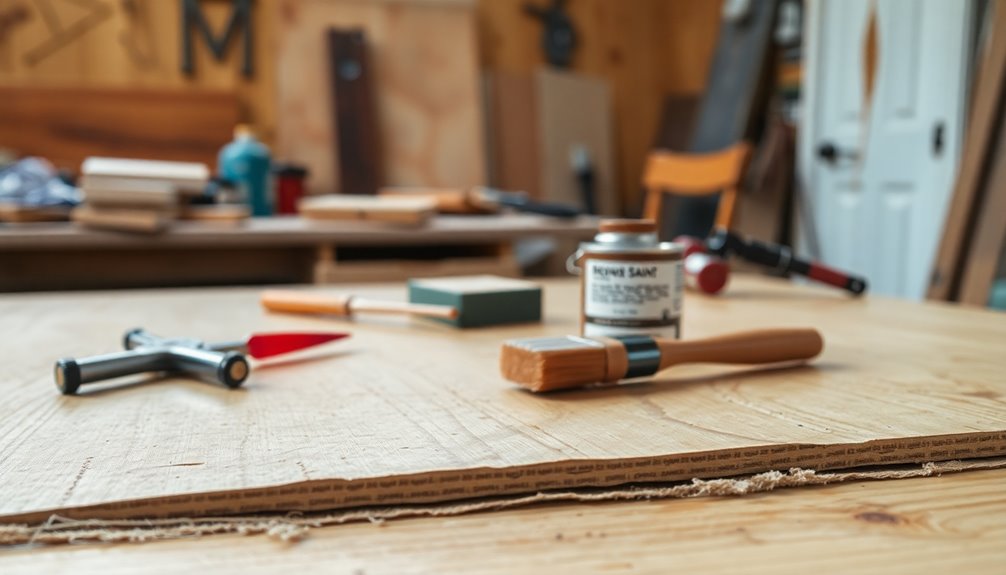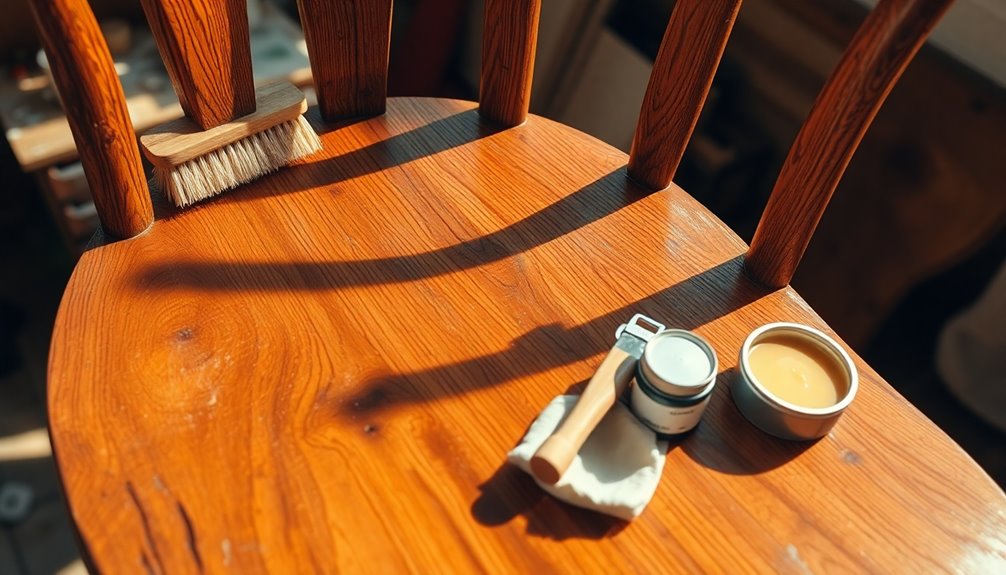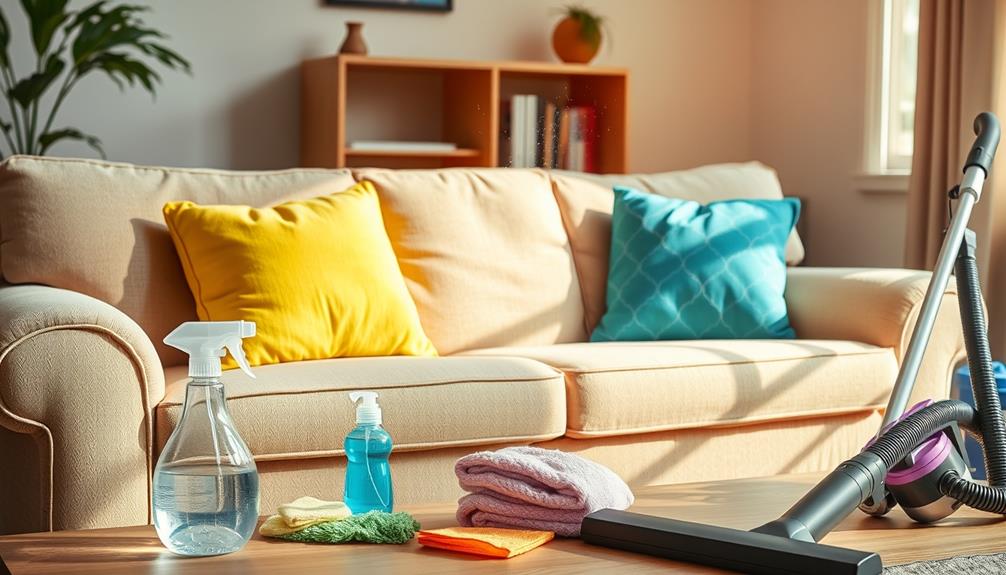To take your sofa out the door, start by measuring both the sofa and the door to ensure it can fit through. Remove cushions to lighten the load and protect them from damage. Angle the sofa slightly as you maneuver it through the doorway, making sure to keep it upright to avoid any scratches. If the door isn't wide enough, consider removing the door frame or taking off the legs of the sofa. Enlist a friend to help you lift and guide it. There are more techniques to ensure a smooth removal, so keep going for tips.
Key Takeaways
- Measure the sofa and door dimensions to ensure it will fit through the opening without obstruction.
- Remove any detachable parts, such as cushions or legs, to lighten the load and improve maneuverability.
- Tilt the sofa at an angle to navigate tight spaces or corners when moving it out the door.
- Use moving blankets or straps to protect the sofa and door frames from damage during the process.
- Enlist help from others to safely lift and carry the sofa, preventing strain or injury.
Introduction
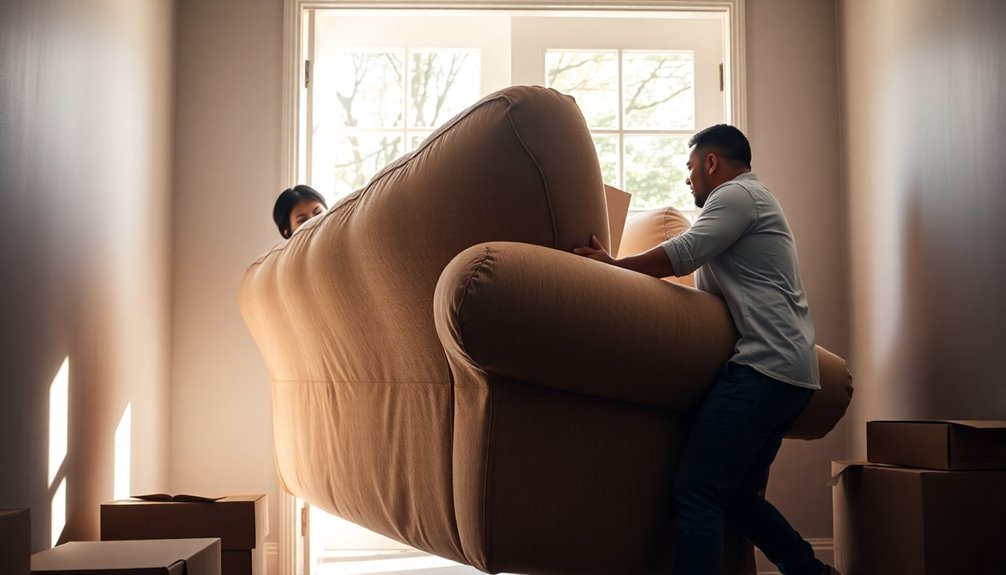
When it comes to keeping your sofa looking great, routine vacuuming and dusting are key. You'll want to use fabric-specific cleaning techniques to tackle different materials effectively. And if you ever spill wine, knowing how to eliminate those stains quickly can save your sofa from permanent damage.
Routine Vacuuming and Dusting
Keeping your sofa clean is essential for a healthy home environment. Routine vacuuming is a must to remove dust, allergens, and debris that can accumulate over time. Use a vacuum cleaner with an upholstery attachment to effectively reach the crevices and fabric surfaces of your sofa. Aim to vacuum at least once a month to maintain its appearance and prolong its lifespan.
To enhance your cleaning routine, combine vacuuming with periodic dusting of your sofa's frame and legs. This will help eliminate any buildup that may occur, ensuring your entire sofa looks its best. After vacuuming, consider using a lint roller or a soft brush to remove hair and finer particles that your vacuum might miss.
Fabric-Specific Cleaning Techniques
Cleaning a sofa can feel daunting, but understanding the specific techniques for different fabrics makes it much easier. Start by checking the manufacturer's care label for guidance. For cotton upholstery, a mixture of mild detergent and water often does the trick. If you have a synthetic fabric, opt for a solvent-based cleaner.
When you're dealing with a leather sofa, use a damp cloth and a leather conditioner to keep it looking fresh and prevent cracking. Just remember, too much water can harm the leather, so be cautious. For microfiber sofas, a specialized cleaner or a simple mix of water and vinegar can effectively tackle stains without damaging the fabric's texture.
Regular maintenance is key; vacuuming and spot cleaning can help maintain your sofa's appearance and extend the fabric's life. This prevents dirt buildup and stops stains from becoming permanent. If you ever need to move your couch, knowing these fabric-specific cleaning techniques can save you a lot of hassle and keep your sofa looking great. By using the right methods, you'll ensure your sofa remains in top condition for years to come. Additionally, implementing regular HEPA filtration can help reduce allergens in your living space, contributing to a healthier environment.
Eliminating Wine Stains Effectively
Although wine stains can be a nightmare, acting quickly can make all the difference in removing them effectively. The first step is to immediately blot the stain with a clean cloth or paper towel. This helps absorb excess liquid without rubbing it deeper into the fabric of your couch. Next, mix one part white vinegar with two parts water and gently dab this solution onto the stained area. The vinegar will neutralize the wine's acidity.
After applying the vinegar solution, sprinkle baking soda over the stain. You'll notice it fizzing, which helps lift the stain while deodorizing the fabric as well. For tougher stains, consider using a commercial upholstery cleaner specifically designed for wine stains, but be sure to follow the manufacturer's instructions closely.
Avoiding Direct Sunlight Exposure
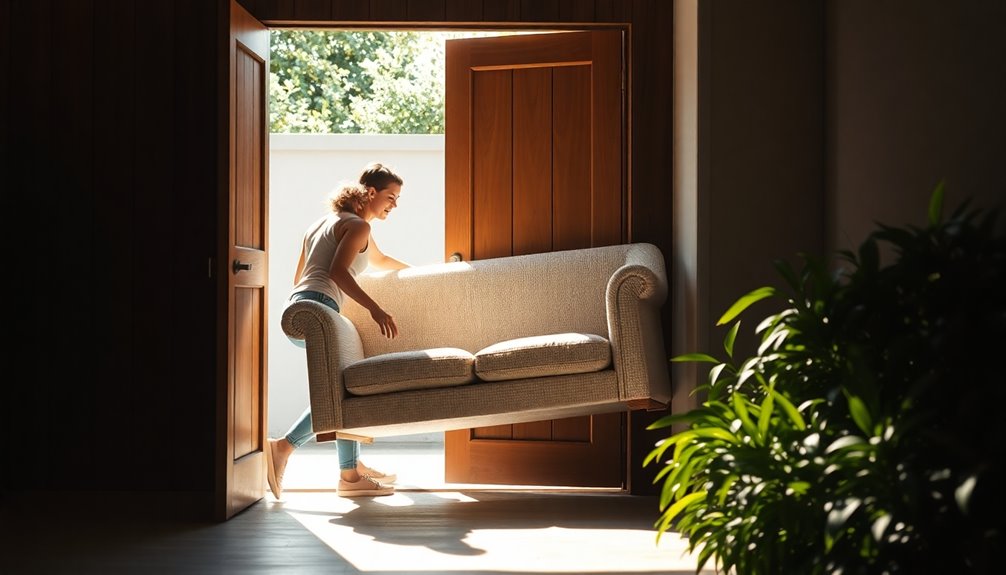
When you're moving your sofa, think about how the fabric can be affected by sunlight. Choosing scratch-resistant fabrics, using protective measures for spills, and regularly rotating cushions can help maintain your sofa's appearance. By taking these steps, you'll ensure your sofa stays in great shape despite exposure to the elements.
Scratch-Resistant Fabric Choices
Choosing the right fabric for your sofa is crucial, especially if you want it to withstand the test of time while looking great. Scratch-resistant fabrics, like polyester and microfiber, are excellent choices since they're durable and can handle daily wear and tear, particularly in high-traffic areas. These fabrics resist snags and tears, ensuring your sofa maintains its appearance even when fit through the doorway.
To preserve the integrity of your sofa, avoid direct sunlight exposure. Sunlight can fade and weaken fabric fibers, so it's wise to position your sofa away from windows. If that's not possible, consider using UV-filtering window treatments to shield your sofa from harmful rays. Additionally, opting for tightly woven fabrics can further improve scratch resistance, minimizing the chances of damage from sharp objects.
Regular cleaning and maintenance are essential too. Dirt and debris can lead to abrasion, diminishing the fabric's lifespan. You might also want to think about using slipcovers made from scratch-resistant materials. They not only provide extra protection against scratches but also help keep your sofa looking fresh and stylish. Understanding topical authority's role in content creation can also guide you to choose the best fabrics that align with your lifestyle and needs.
Fabric Protection for Spills
Protecting your sofa from spills is essential for maintaining its appearance and longevity. One effective way to achieve this is by applying a fabric protector spray that repels liquids and stains. This proactive step ensures that your upholstery stays fresh and clean, even when accidents happen.
Additionally, it's crucial to consider the placement of your sofa. Avoid putting it in direct sunlight, as UV rays can cause the fabric to fade and deteriorate over time. Not only does this exposure reduce the overall lifespan of your furniture, but it can also lead to uneven wear and discoloration.
To further safeguard your sofa, use throw blankets or slipcovers during activities that might lead to spills, like eating or drinking. These extra layers act as barriers, helping to keep your upholstery safe from potential damage.
If a spill does occur, remember to blot the area immediately with a clean cloth. Rubbing can push the stain deeper into the fabric, making it harder to remove. By taking these steps, you'll help ensure your sofa remains a stylish and durable centerpiece in your home for years to come.
Regularly Rotate Cushions
Your sofa's cushions deserve regular attention to keep them looking their best and lasting longer. One simple way to achieve this is by rotating them every few weeks. This practice helps prevent uneven wear, ensuring that all sides face equal pressure and light exposure. It's especially important if you frequently use your sofa, as this can lead to sagging and discomfort.
In addition to rotating, you should avoid direct sunlight exposure. UV rays can fade fabrics and weaken the cushion structure over time, leading to discoloration and reduced durability. If your sofa is near a doorway where sunlight streams in, consider using protective covers when the couch isn't in use. This will shield the cushions from both sunlight and dust, further enhancing their lifespan.
Lastly, maintaining a consistent cleaning schedule is crucial. Regular vacuuming and spot cleaning will help prevent dirt buildup, which can contribute to fading and wear. Additionally, using pet-specific sprays can help reduce shedding from pets that may lounge on your sofa. By taking these steps, you can ensure your sofa remains in great condition, even when you're couch moving or rearranging your living space. Your cushions will thank you for the extra care!
Cushion Replacement Strategies
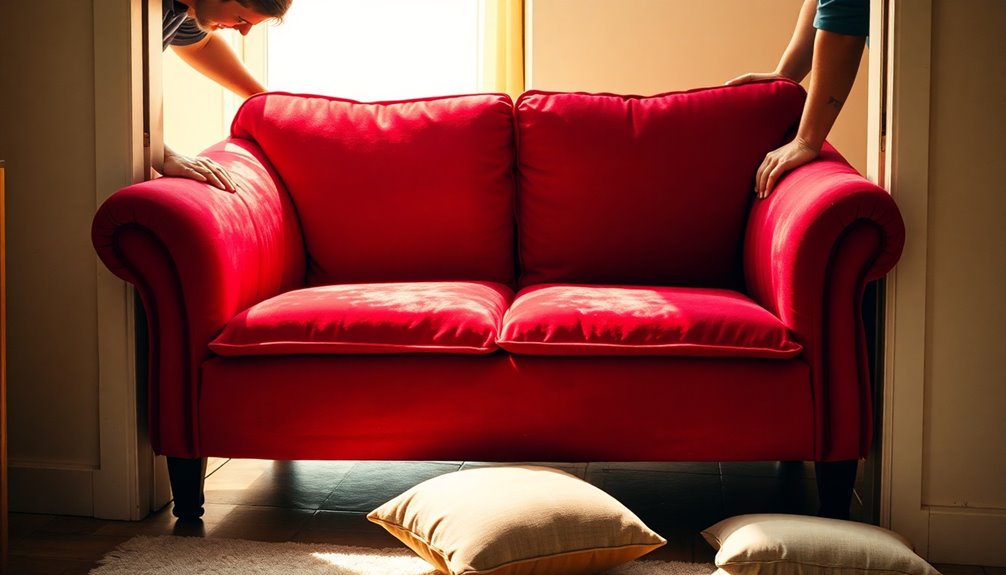
When you're replacing your sofa cushions, keep in mind the integrity of the frame; poor support can lead to sagging. You might also want to explore leather repair techniques if your cushions are part of a leather sofa, ensuring a cohesive look. Finally, revitalizing cushion support with the right materials can significantly enhance your seating comfort.
Frame Integrity Concerns
To maintain the integrity of your sofa's frame, it's crucial to handle cushion removal and replacement with care. When you disassemble the couch, check for any hidden staples or fasteners that could damage the frame during the process. Removing cushions without taking these into account can lead to structural issues that compromise frame integrity.
If you find that the cushion covers are worn, consider replacing them with high-quality fabric to enhance both comfort and durability. Properly fitting cushions will prevent sagging over time and ensure the sofa looks great after reassembly.
As you disassemble, document the arrangement of all detachable components. This helps you put everything back together correctly, preserving the sofa's original integrity. If you notice that the frame has weakened, use scrap wood as braces to reinforce its stability. This is especially important after cutting the sofa to fit through tight door frames.
Leather Repair Techniques
Regularly assessing the condition of leather cushions can prevent larger issues down the line. When it's time to replace those worn-out cushions, choose high-quality leather that matches your sofa's original upholstery in color, texture, and durability. This keeps the aesthetic intact and ensures longevity. Start by using a seam ripper to carefully detach the old leather from the cushion, taking care to preserve the underlying foam for reupholstering or replacement.
For a professional finish, apply leather adhesive or staples to secure the new leather, making sure it's taut and smooth without any wrinkles. Consider adding a layer of foam padding to enhance comfort and restore the cushion's original shape before covering it with leather. Additionally, using the best leather dyes can help maintain the cushion's appearance and prolong its life.
If you're using leather dyes or conditioners, always test them on a small area first to avoid any unexpected changes in color or texture. Remember, if you're removing cushions from the sofa to work on them, be cautious of your door frame to prevent any damage. By following these leather repair techniques, you'll maintain both the look and feel of your beloved sofa for years to come.
Revitalizing Cushion Support
Assessing your sofa's cushion support is crucial for maintaining comfort and longevity. Regularly inspect your cushions for wear and sagging. If you notice these signs, it's time to consider replacement to ensure your sofa remains inviting.
When replacing foam cushions, opt for high-density foam; it offers improved durability and can last up to 10 years with proper care. If you prefer a softer feel, down or polyester fiberfill will enhance your comfort. For those who value support, memory foam contours to your body shape, providing tailored comfort.
Before you purchase new cushions, measure the dimensions of your original ones carefully. This step is vital to avoid any sizing issues that could compromise fit and comfort. Additionally, ensure that the new cushion covers match the original fabric or style of your sofa, preserving its aesthetic while giving it a refreshed look. Regular inspection of essential safety equipment can prevent accidents during home maintenance tasks like cushion replacement.
Upholstery Fabric Upgrades
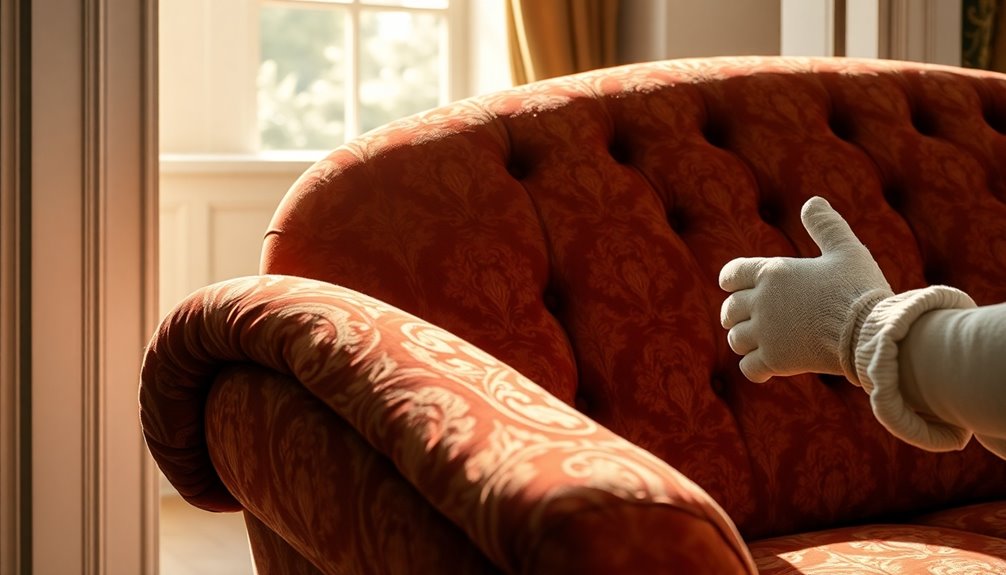
Upgrading your sofa's upholstery fabric can dramatically transform its look and feel, making it a worthwhile investment for any living space. When choosing upholstery fabric, consider popular options like cotton, linen, and microfiber. Each material brings unique textures and durability to your sofa. If you have kids or pets, performance fabrics that are stain-resistant and water-repellent are perfect for handling spills and wear.
The choice of fabric not only affects your sofa's visual appeal but also its comfort and longevity. For instance, high-quality leather ages beautifully and tends to be easier to clean compared to fabric alternatives. Make sure to check the Martindale rub test rating when selecting upholstery; fabrics rated over 30,000 rubs are considered suitable for heavy-use furniture.
Custom upholstery can take your sofa upgrade to the next level, allowing you to match your sofa to your existing decor. You can choose from various patterns, colors, and textures that reflect your personal style. With the right upholstery fabric, you can create a stunning focal point in your room while ensuring your sofa remains functional and stylish for years to come.
Seasonal Fabric Care Tips
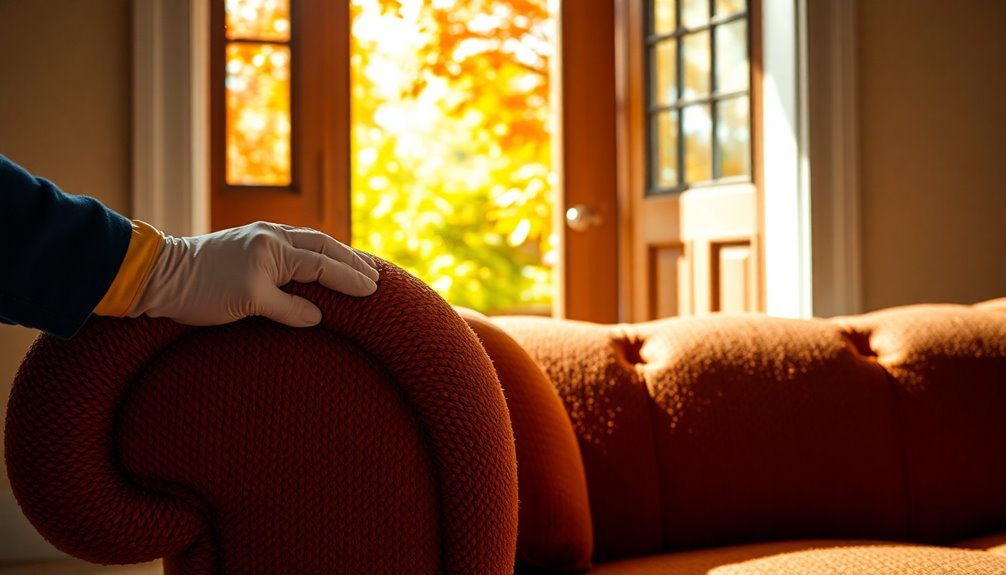
Maintaining the beauty and longevity of your upgraded upholstery fabric requires attention, especially with changing seasons. To keep your sofa looking its best, regularly vacuum it with a brush attachment, ideally every week during high-use seasons like winter and summer. This helps remove dust, dirt, and allergens that can accumulate.
Consider applying a fabric protector spray to guard against stains and spills, reapplying it every six months for optimal effectiveness. Don't forget to deep clean your sofa at least once a year—steam cleaning or hiring a professional upholstery cleaner will help maintain fabric integrity and appearance.
During seasonal changes, rotate and fluff your cushions to prevent uneven wear and keep their shape, particularly for sofas used frequently. If you have sofa covers or throws, store them in a cool, dry place during the off-season. Make sure they're clean before storing to prevent mildew and musty odors.
Conclusion
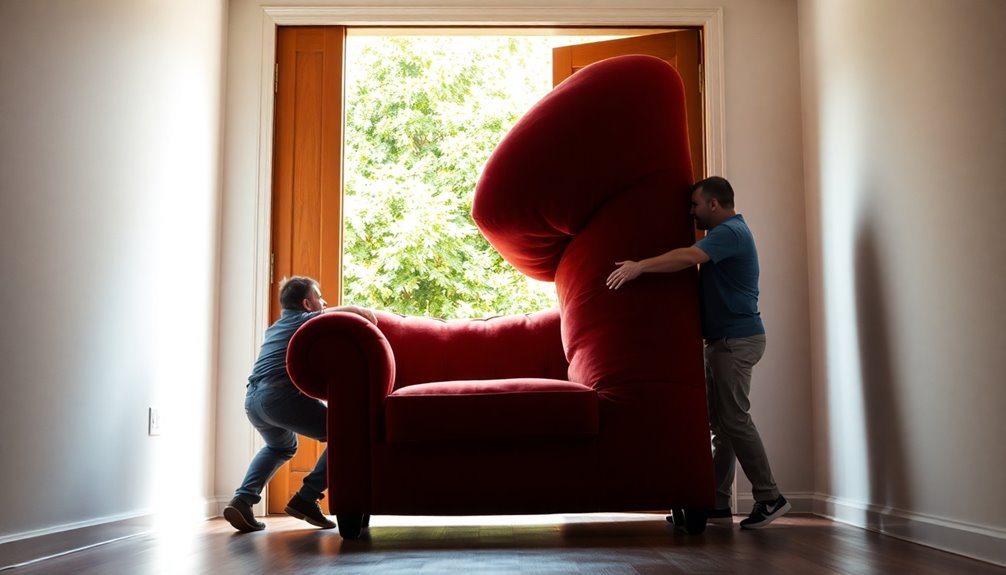
In conclusion, successfully taking a sofa out of a door requires careful planning and execution. First, measure both the sofa and the doorway to ensure a proper fit. Generally, couches under 80 inches wide can maneuver through standard doors, but double-checking is key. Clear any obstacles in the pathway and consider removing the door from its hinges to gain extra space, as this can increase the opening width by up to 1.5 inches.
Disassembling the sofa by removing cushions and legs can help reduce its bulk, making it easier to navigate through narrow spaces. Techniques like standing the sofa on its end or using the pivot method can aid in maneuvering it effectively through doorways. Always make sure you have enough people to help with lifting heavy objects, and prioritize safety to avoid injuries during the move.
Frequently Asked Questions
How to Know if a Sofa Fits Through a Door?
To know if a sofa fits through a door, start by measuring both the sofa and the doorway. You'll want to check the width, height, and depth of the sofa, including any removable parts. Then, measure the doorway's dimensions, noting any obstructions. Compare these measurements carefully. If the sofa's dimensions are smaller than the door's, you're likely good to go. If it's close, consider tilting or angling the sofa for a better fit.
How to Get a Sofa Out the Door?
To get a sofa out the door, start by measuring both the sofa and the doorway to ensure a fit. Remove any detachable parts to simplify the process. If it doesn't fit, consider taking the door off its hinges for extra space. Use furniture sliders or a dolly to help lift and maneuver the sofa safely. Remember to tilt it at an angle for tight spots, keeping everything level and secure.
What to Do if a Sofa Doesn't Fit Through the Door?
If your sofa doesn't fit through the door, start by measuring both the sofa and the doorway to confirm the dimensions. If it's too wide, consider removing the door from its hinges to gain extra space. You can also disassemble the sofa by taking off its legs and cushions to make it less bulky. Finally, try the pivot technique, tilting and rotating the sofa as you approach the doorway to maneuver it more easily.
How to Dismantle a Sofa to Fit Through a Door?
To dismantle a sofa, start by measuring its dimensions and the doorway. Remove cushions and legs first to lighten the load. Use tools like screwdrivers and pliers to take off arms and backrests, keeping screws organized in labeled bags. Document the disassembly process with photos for easy reassembly. Once disassembled, check if the parts can fit through the door horizontally or vertically, adjusting your approach as needed for the best fit. Finally, when transporting the disassembled pieces, ensure you protect them with blankets or padding to prevent damage. If you’re unsure how to safely disconnect a sofa, consult the manufacturer’s guidelines or seek assistance from someone with experience in furniture assembly. This will not only help preserve the integrity of the sofa but also make the entire moving process smooth and efficient.
